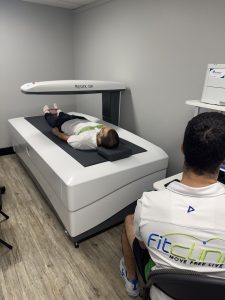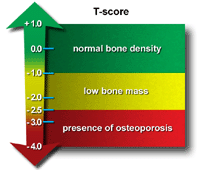DEXA: What is it? How can it help me?
What is a DEXA used for?
Dual Energy X-ray Absorptiometry (DEXA) is a medical imaging device that examines a person’s body composition. It can be useful for people looking to improve their muscle mass, fat tissue and bone mineral density. DEXA is the GOLD STANDARD for measuring a person’s body composition. A DEXA test will assess body composition and it can play a role in reducing medical conditions.

Body fat measurement
Fat mass and fat mass index
Fat mass index is your total fat mass divided by your height squared. This is a better indicator than body mass index since it measures absolute amount of fat in the body in comparison to height.
Total body fat %
This is the percentage of fat that is contained within your body. To improve this percentage, you can either reduce fat, increase muscle or both. A higher body fat percentage can indicate lowered cardiometabolic health. It can be a risk factor for diabetes, insulin resistance, certain cancers and cardiovascular disease.
The body fat % can be compared to your age-matched norms for your gender. As an example, 39-year-old male who has 25% body fat is in the “high” range (Gallagher et al., 2000).
As a person ages, they are expected to have a higher body fat percentage primarily due to a loss of muscle mass. So, 25% body fat on a male who is in their early 20s is worse for their cardiometabolic health.
Distribution of fat
DEXA will measure the distribution of fat in the body. Higher visceral fat poses the highest risk associated with cardiometabolic conditions including ischaemic heart disease, arterial hypertension, type 2 diabetes, and certain types of cancers. This type of fat is the fat that surrounds the organs.
Bone mineral density
The DEXA will provide you with a T score and a Z score to measure your bone mineral density.
The T score compares your bone mineral density to a healthy young adult. The Z score compares your bone mineral density to people of your age and gender.
Measuring T score and Z score is of more importance to the older population as it can assess their risk of osteoporosis. A normal age-related change is loss of bone mineral density, and it is important to measure the decline in bone mass. It can indicate to the elderly what type of medical or lifestyle changes need to be done to address their needs.
A DEXA is the gold standard to measure bone mineral density. Below is an infographic to show the normative data for a T-score.

Lean muscle mass
A DEXA will measure the amount of muscle in your body. This is important to measure as it can highlight to an individual the amount of muscle they have in their body. It can indicate if muscle mass needs to be increased. High muscle mass is linked with higher resting metabolic rate, improved strength, greater force application in field sports, reduced risk of falls and reduction in all-cause mortality. The DEXA can also show regional muscle mass.
Regional muscle mass
Regional muscle mass refers to the amount of skeletal muscle tissue in specific areas of the body, such as the lower limbs, upper limbs, trunk, or extremities.
This will provide insight into muscle mass distribution in the body which can be important for certain athletes returning to their sport after injury time-off. It can provide valuable information to coaches and training staff in providing an exercise program that is tailored to the weaknesses of the athlete.
For example, a sprinter who has torn their hamstring muscle can determine the muscle bulk difference between the left and right leg. The information can indicate what needs to improve and by exactly what percentage, potentially reducing the chances of injury recurrence. This is significantly important in elite sport where injuries need to be minimised as much as possible.
Why not just use a scale to measure body composition?
A scale only provides people with their body weight. A person can also work out their BMI if they were to put their weight into this equation: Weight/(height)². A person’s body weight gives us an idea of how heavy a person might be, but it doesn’t provide information regarding the breakdown of their body composition.
This is the drawback of using BMI as the only indicator of health. There can be elite athletes that play rugby union who might be in the “overweight” category of health when using BMI. However, majority of their weight might be attributed to total muscle mass and bone mass. This is why DEXA can be useful here in showing us where is the distribution of total weight.
Thus, DEXA tests can help predict some medical conditions through the assessment of body composition.
What are the contraindications to using a DEXA?
There are very little contraindications to using a DEXA. While DEXA is generally safe, the risk of radiation exposure to the fetus is higher, so it’s not recommended for pregnant individuals. Please confirm with the practitioner on whether you are pregnant or not before undertaking a DEXA scan.
What to do with my DEXA results?
Once you have received your DEXA results, you can start to create a little plan with your health practitioner. The direction in which you choose to take is related to your health goals and lifestyle factors.
Weight loss
If losing weight is important to you, the DEXA results will show you what your resting metabolic rate is (this is important when calorie tracking) and what your fat distribution is. It also shows the amount of visceral fat and what it might mean in relation to chronic disease. Chronic disease is on the rise in Australia which is another reason to support the idea of fat tissue reduction in the medical field.
Check out this link if you were curious about lifestyle risk factors, coronary artery disease and exercise: https://www.healthdirect.gov.au/coronary-heart-disease-and-atherosclerosis
Check out this blog link here to help you understand more about sustainable weight loss:
Muscle mass building
The DEXA scan can also determine where the muscle distribution is in the body and what percentage is lean muscle. If building muscle is important to your health goals, the DEXA result can show you where you lack muscle mass. It can then inform exercise prescription and programming to align with your fitness goals.
DEXA is also common in other countries and organisations. If you are still interested in learning about DEXA, the University of California have composed an insightful blog on DEXA and its value in the sport setting:
https://health.ucdavis.edu/sports-medicine/resources/dxa-info
The information provided in this article is considered general advice. For specific advice related to your individual circumstances, speak to your healthcare provider.
If you like what you’re hearing from us Fit Clinic, subscribe to our social media channels, YouTube, Facebook, and Instagram. You can find us at Fit Clinic AU.
Otherwise, pop over to our website and subscribe there fitclinic.com.au to hear more from us.
